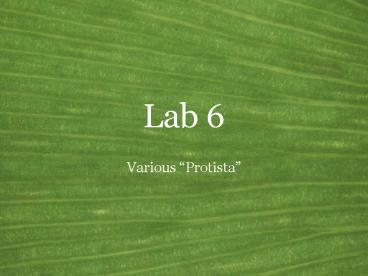Lab 6 - PowerPoint PPT Presentation
1 / 36
Title:
Lab 6
Description:
Lab 6 Various Protista Dictyosteliomycota Common name: Cellular slime molds Synonyms: Acrasiomycota (in part) Mode of nutrition: Heterotrophic: ingestive ... – PowerPoint PPT presentation
Number of Views:117
Avg rating:3.0/5.0
Title: Lab 6
1
Lab 6
- Various Protista
2
Dictyosteliomycota
- Common name Cellular slime molds
- Synonyms Acrasiomycota (in part)
- Mode of nutrition Heterotrophic ingestive
- Habitat Terrestrial moist decaying vegetation
- Growth habit Unicellular myxamoebae (ingestive
cells), multicellular dispersal structure - Cell wall None in myxamoebae, cellulose in
sporangium
3
Dictyosteliomycota
- Undulipodia (flagella) None
- Food storage Glycogen
- Clonal reproduction Mitosis of myxamoebae
production of aplanospores for dispersal - Sexual reproduction Rare and poorly known
- Representative genera Dictyostelium
- Recognized by slugs, individual (not grouped)
stalked sporangia
4
Dictyostelium
5
Myxomycota
- Common name Plasmodial slime molds
- Synonyms Mycetozoa
- Mode of nutrition Heterotrophic ingestive
- Habitat Terrestrial moist decaying vegetation
- Growth habit Multinucleate single-cell
plasmodium - Cell wall None
- Undulipodia (flagella) One or two whiplash on
aquatic haploid uninucleate cells otherwise none
6
Myxomycota
- Food storage Glycogen
- Clonal reproduction None
- Sexual reproduction Diploid phase resembles
diploid dominant haploid phase resembles
unicellular - Representative genera Arcyria, Dictydium,
Physarum, Stemonitis - Recognized by Plasmodium meiosporangia often
clustered.
7
D Physarum plasmodium
Myxomycota
8
D Stemonitis
Myxomycota
9
A Stemonitis
Myxomycota
10
D Arcyria
Myxomycota
11
D Arcyria
Myxomycota
12
D Dictydium
Myxomycota
13
A Dictydium
Myxomycota
14
D Lamproderma
Myxomycota
15
D Lamproderma
Myxomycota
16
D Physarum
Myxomycota
17
A Lycogala
Myxomycota
18
Euglenophyta
- Common name Euglenas
- Synonyms None
- Mode of nutrition Autotrophic green
chloroplasts (secondary), or heterotrophic by
ingestion - Habitat Freshwater
- Growth habit Unicellular
- Cell wall None (a proteinaceous pellicle beneath
the plasma membrane provides stiffness)
19
Euglenophyta
- Undulipodia (flagella) Whiplash one long for
swimming, one short, confined to the vacuole - Food storage Paramylon
- Clonal reproduction Mitosis by unicells
- Sexual reproduction None known
- Representative genera Euglena, Phacus
- Recognized by Green but no cell wall, eyespot
often prominent
20
U Euglena
Euglenophyta
21
D Euglena
Euglenophyta
22
Dinophyta
- Common name Dinoflagellates
- Synonyms Pyrrhophyta
- Mode of nutrition Autotrophic brown
chloroplasts (secondary), or heterotrophic by
ingestion - Habitat Marine, freshwater
- Growth habit Unicellular
- Cell wall Cellulose or none
23
Dinophyta
- Undulipodia (flagella) Ordinarily two
whiplash, one in equatorial groove and one in
longitudinal groove - Food storage Chrysolaminarin
- Clonal reproduction Mitosis by unicells
- Sexual reproduction Poorly known in many
species, some with complex sexual cycles - Representative genera Ceratium, Gonyaulax,
Noctiluca, Peridinium, Pfiesteria - Recognized by Grooves for flagella
24
A Peridinium
Dinophyta
25
A Noctiluca
Dinophyta
26
A Ceratium
Dinophyta
27
Rhodophyta
- Common name Red algae
- Synonyms None
- Mode of nutrition Autotrophic red chloroplasts
- Habitat Marine, freshwater
- Growth habit Multicellular filamentous or
plectenchyma multicellular crusts and films,
rarely unicellular. - Cell wall Cellulose, galactans such as agar and
carrageenan
28
Rhodophyta
- Undulipodia (flagella) None (no basal bodies)
- Food storage Floridean starch
- Clonal reproduction aplanospores
- Sexual reproduction Isomorphic alternation of
generations with interpolated carposporophyte
phase, oogamous - Representative genera Chondrus, Corallina,
Polysiphonia, Porphyra - Recognized by Red plants no flagella
cystocarps tetraspores
29
A Polysiphonia tetrasporophyte
Rhodophyta
30
A Polysiphonia male gametophyte
Rhodophyta
31
A Polysiphonia cystocarp
Rhodophyta
32
D Polysiphonia
Rhodophyta
33
D Various red algae
Rhodophyta
34
D carrageenan
Rhodophyta
35
D agar
Rhodophyta
36
D nori
Rhodophyta































